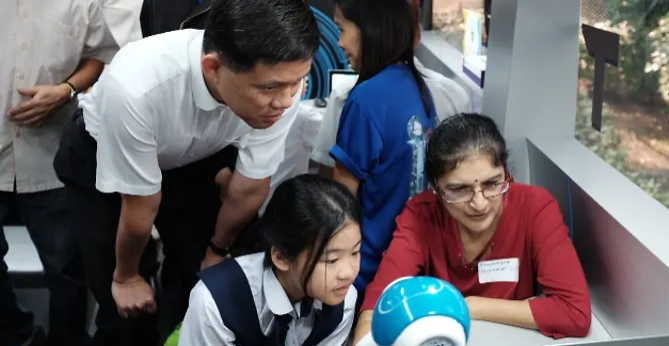KEEP IN TOUCH
Subscribe to our mailing list to get free tips on Data Protection and Cybersecurity updates weekly!






Instances from the ground reveal significant struggle in terms of digital literacy and skills, particularly among low-income households, the differently-abled, and seniors, says Nominated Member of Parliament Anthea Ong.

SINGAPORE: We are now forced online to learn, work, live and stay connected.
Yet due to the lack of internet connectivity, requisite devices or digital literacy, there are many who are cut-off from such access.
They are not digital natives nor immigrants, they are digital outcasts.
COVID-19 has exposed and deepened the digital divide in our society. Given the speed at which most of society is moving ahead, closing this gnawing digital divide must be an urgent priority if we are to have a Smart Nation that is also united.
I will address three questions: How deep is the digital divide? What factors contribute to the divide? And what solutions can we consider?
HOW DEEP IS THE DIGITAL DIVIDE IN SINGAPORE?
The latest Household Expenditure Survey 2017/2018 tells us that only 81 per cent of resident households have a personal computer, and only 87 per cent have internet access.
This suggests that at least one in 10 households in Singapore are not plugged into our digital world.
Only 45 per cent of households residing in 1- and 2-room HDB flats have internet access, compared to 96 per cent of households living in private condominiums and other apartments.
Only 31 per cent of the 1-2 room HDB households have a personal computer, in contrast with 95 per cent of households in private condominiums and other apartments.
These numbers mean that some of us are almost guaranteed to have internet connectivity and a personal computer, while more than 5 in 10 households living in 1-and 2-room HDB flats have no internet access or personal computer.
This is also reflected in the ground realities exposed by home-based learning (HBL).
The Ministry of Education (MOE) has loaned out an estimated 20,000 devices, including laptops and tablets.
A few community groups I personally know and supported, including Engineering Good, have given out more than 2,600 laptops in total. They have also provided Wi-Fi dongles or SIM cards to several families.
The bleak picture does not end at infrastructure. Stories from the ground reveal significant struggle in terms of digital literacy and skills, particularly among low-income households, the differently-abled, and seniors.
ReadAble, a community organisation supporting families in rental flat communities, shared the many struggles of parents using laptops donated – whether with Zoom or even in-app functions, resulting in their children’s education being compromised.

According to Society Staples, a social enterprise working with the persons with disabilities (PWD) and the Disabled Persons Association, many PWDs have difficulty working from home due to a lack of equipment and Internet access.
Some do not have the skills-set to take their work online especially when their previous work was done face-to-face.
This can mean loss of income and opportunities to retrain or learn new skills.
They also miss out on maintaining or even expanding connections with family and friends, which increases mental stress and strains existing coping mechanisms, especially for those with psycho-social disabilities.
Cassia Resettlement Team, a community organisation, has had to support many low-income individuals, particularly seniors, who struggle with the digitisation of government services.
For example, SingPass is required to access many such services including checking Central Provident Fund (CPF) accounts, which are regularly required to apply for welfare schemes, checking medical appointments or medical tests results and prescriptions.
In 2006, the Government’s iN2015 Masterplan pledged that every household with a school-going child would own a personal computer by 2015.
I remember this clearly as I was running my own education technology company then and was very energised by this vision of a digital future which my company also participated in.
Sadly, despite this iN2015 ambition, our efforts to become a Smart Nation since 2014 and the Digital Readiness Blueprint released in 2018, we continue to struggle with a deep digital divide in Singapore.
STRUCTURAL ISSUES PERPETUATING THE DIGITAL DIVIDE
One of the structural issues that stand out as perpetuating the digital divide is the gaps in government intervention.

Market forces are the key driver of this divide. Although internet connectivity and personal computers are necessities in today’s world, they are still priced beyond the reach of the low-income in our society.
This disparity in turn perpetuates further inequality.
The Government intervened by introducing the NEU-PC Plus Scheme in 2006, offering students and PWDs from low-income households a new personal computer bundled with three years of free internet connectivity.
While it has benefitted more than 40,000 households, the scheme falls short in several ways.
First, it only permitted one laptop per eligible household regardless of household size, increasing to two only last month due to HBL.
Second, the application process is complex and bureaucratic.
Third, it is limited in scope, excluding pre-school, home-schooled and university students.
Fourth, it disadvantages against PWDs, who only receive a 50 per cent subsidy as compared to 75 per cent for students.
Fifth, under the Home Access scheme, adults have no option to apply for a personal computer, only a tablet or smartphone.the
I commend MOE and the Infocomm Media Development Authority (IMDA) for working hard to resolve digital access issues during this circuit breaker period.
IMDA enhanced the NEU-PC scheme. MOE worked with schools to loan out personal learning devices and kept schools open for those who struggled with digital access.
But gaps persist. The device loan programme came with conditions and liability provisions.
Community organisation 6th Sense shared that there were families who were too scared to bring those devices home as they would not be able to afford to pay the schools if the devices got lost or broken.

Further, the families were rightly worried about going to school and risking COVID-19 infection. One teenage student I know developed severe anxiety when she had to go to school every day before HBL began.
Why should any child be required to go to school to use IT facilities at the height of a pandemic?
Given these gaps, community organisations found that it made more sense to give every family good internet connection and every child a personal computer.
The Minister for Education has said that, by 2024, every Secondary 1 student will have a tablet, a laptop, or a chromebook.
I propose a broader Digital Adequacy Framework, which I will elaborate later.
MOVING TOWARDS DIGITAL INCLUSION FOR SGUNITED
The Ministry of Communications and Information (MCI) has boldly committed in its Digital Readiness Blueprint that all Singaporeans will be digitally ready, no matter their income or current IT abilities.
I would like to offer some suggestions from the ground regarding enhancements to existing schemes and structural changes.
The NEU-PC Plus Scheme’s application process could be further streamlined, for instance, by allowing beneficiaries of the various financial assistance schemes to automatically qualify.
Can the Ministry of Social and Family Development (MSF) and MOE work together to ensure that every family with a child on MOE’s Financial Assistance Scheme (FAS), or every family supported by ComCare who has a child in school, automatically gains adequate access to a fully subsidised personal computer?
IT subsidy schemes should include device replacement and customer care.
Adults supported under ComCare or residing in HDB rental flats should also have the option of receiving a partially or fully subsidised digital device, depending on their income.
The scheme should also be broadened immediately to permit applications to benefit all children whether preschool, home-schooled or university students, and adults from low-income families.
PWDs must be better supported given the changing nature of work post COVID-19.
To reduce the time and resources required to deliver digital devices to families, we may need a Digital Empowerment Voucher (DEV) scheme that combines aspects of the existing Public Transport Voucher and Innovation & Capability Voucher schemes.
The vouchers could be stipulated for use only with local SMEs which would directly assist our local enterprises in these trying times.
To realise the Digital Readiness commitment to provide digital connectivity and devices for those with limited resources adequately, a Digital Adequacy Framework should be considered.

Because it’s not enough to just be digitally ready or included, this digital participation must adequately support their learning, work and social connections meaningfully.
Under this Framework, tablets must be decoupled from the definition of “personal computer” across the board for learning and work purposes.
We should also view the amount of hardware deemed adequate for each household to be based on the needs of each member in it.
For instance, should every student in Primary 5 and above not have their own laptop, considering the MOE’s digital literacy plans for upper primary students?
The Framework should also fold internet speed, hardware functionality and digital literacy into its analysis to enable meaningful digital participation.
Within this Framework, universal internet access should be provided as a public utility especially for low income households.
Can IMDA and HDB work with commercial providers and town councils to ensure that all low-income households have adequate internet connection?
For instance, can Wireless@SG be expanded to cover all rental flats in Singapore, and enhanced for sufficient speed much like the ubiquitous Wi-Fi access available in shopping malls?
Finally, the Digital Adequacy Framework should underpin the Digital Readiness Blueprint.
Much public policy has been characterised by efficiency, effectiveness and economy, with emphasis on outcome measures that can be determined more by what can be easily measured than by what might be most helpful to measure.
Meaningful statistics and metrics across all vulnerable groups should be gathered regularly to inform policy design and updates.
In the UK, for example, the Office for National Statistics studies the digital divide across locations, gender, age, income, disability, ethnic groups/language, education and other social and economic determinants of digital inequality.
COVID-19 has spotlighted our deep digital divide and the digital outcasts in our midst.
Our clarion call for SGUnited must surely be a Singapore that is digitally resilient and united.
Download our app or subscribe to our Telegram channel for the latest updates on the coronavirus outbreak: https://cna.asia/telegram
Anthea Ong is a Nominated Member of Parliament, a social entrepreneur (founder of Hush TeaBar, A Good Space, WorkWell Leaders Workgroup), leadership coach and author of 50 Shades of Love. www.antheaong.com.
Source: CNA/ml